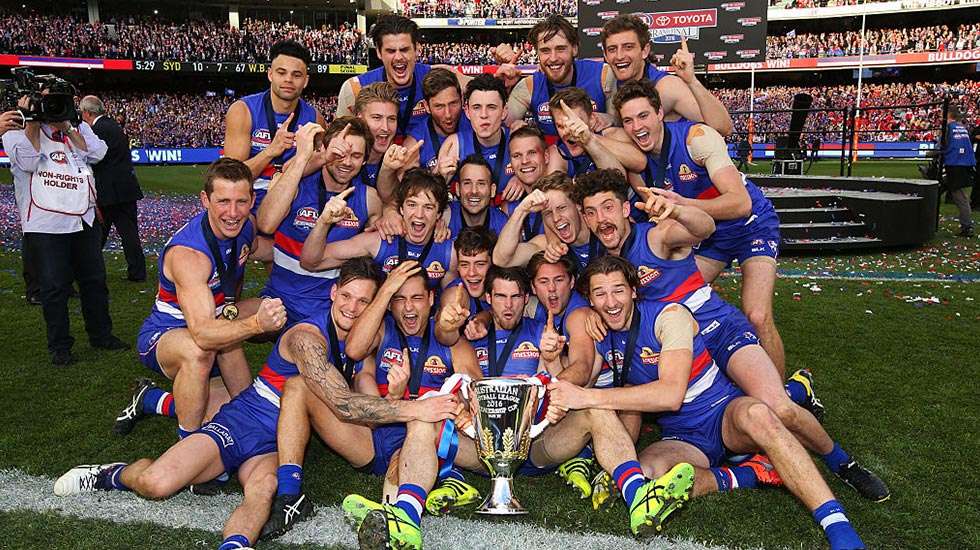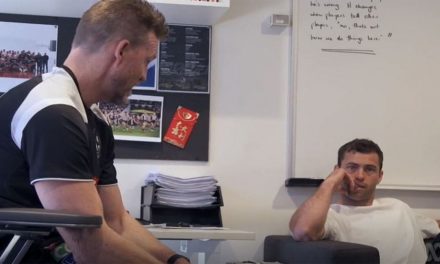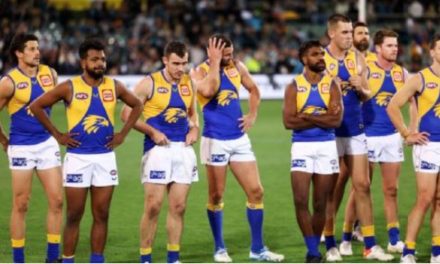Why not us? The Western Bulldogs’ unconventional premiership triumph offers some salient lessons for this year’s flag aspirants. Photo: AFL MEDIA
Why not us? Finals class of 2017 can learn from Bulldogs
The AFL’s latest advertisement for the upcoming finals series opens with Fox Footy commentator Anthony Hudson asking: ‘Why not us?’
This phrase became the Western Bulldogs’ motto during their unlikely premiership run last season, repeated among the playing group during finals to instil belief in their own abilities.
Despite few outside the club giving them a chance to win a final, let alone the flag, the Bulldogs were driven by an insatiable faith that they could match it with the very best.
Unfortunately for the Dogs, they’ve missed out on the chance to compete for September glory again this year. But that doesn’t mean this season’s finalists can’t learn from their unconventional path to success.
The Bulldogs in 2016 bucked a number of accepted wisdoms when it comes to winning finals. They were a young, inexperienced team, with 14 of their players on grand final day having played less than 100 games (by comparison Hawthorn’s 2008 grand final side only had one player with less than 100 games experience).
They were a low-scoring team (ranked 12th in the competition) with no recognised key forward. And they had to win from seventh position, from where no club had ever come to win a flag before. So what can this year’s finalists take out of those unusual circumstances?
Firstly, one has to consider the bye, which many have felt was a considerable factor in the Bulldogs’ success last September. Even though all finals teams received a bye, and the top four teams still received a double chance, it has undoubtedly proved a significant advantage for certain clubs.
Last year, it favoured the Bulldogs, who were able to bolster their line-up with four key injured players returning for their elimination final against West Coast.
Tom Liberatore (ankle), Easton Wood (ankle), Jack Macrae (hamstring) and Jordan Roughead (calf) were all welcomed back from injury, which wouldn’t have been possible without a week’s break.
Ironically, one team who appeared to be hurt by the pre-finals bye last year may be singing its praises this time around.
In 2016, Geelong headed into its preliminary final clash with the Swans playing just its second game in 27 days due to the bye and their qualifying final victory over Hawthorn in week one of the finals.
As a consequence, the Cats were slow out of the blocks on the night, allowing Sydney to heap on seven unanswered goals in the first term to effectively kill the contest.
This time around, the Cats are sweating on the fitness of captain Joel Selwood, who may return for their highly-anticipated qualifying final clash with Richmond. Without the bye, Geelong would not have the luxury of playing its star on-baller.
As for the Cats’ opponents, the Tigers, they can learn from the Bulldogs’ ability to be inspired, rather than hindered, by the fairytale narrative being constructed around them.
The pressure of breaking a premiership drought and appeasing long-suffering fans will perhaps be even more intense for Richmond, given the club’s enormous fan base, but the Bulldogs showed that passionate fan support can be a driving force towards success.
Richmond can also learn from the Dogs’ unconventional forward line, which relied mainly on high-pressure small forwards and a goal-kicking midfield to score during September last year.
The Tigers of 2017 still have a reliable key forward in Jack Riewoldt, but he is well-supported by an array of impressive small forwards, with Daniel Butler, Jason Castagna and Daniel Rioli kicking 70 goals between them this season.
Star midfielders Dustin Martin, Trent Cotchin and Josh Caddy have also combined for 65 goals, making for quite a formidable and versatile forward mix.
Teams outside the top four can also take in heart in the Dogs’ premiership run from seventh place, which proves the double chance is not needed if a team can feed off significant momentum.
Sydney, in particular, will be licking its lips at the thought of this as they are the competition’s undoubted form team heading into September. How difficult can four wins in a row be, when the Swans have already won 14 of their last 16?
While pundits love nothing better than to rule certain teams out of premiership contention, the reality is no team has been truly dominant enough this season for this to be the case.
The obvious favourites, Adelaide, GWS and Sydney, have all suffered form slumps at some stage, while lower-ranked top eight teams (like Essendon and Port Adelaide) have shown impressive fire power when in full throttle.
Even West Coast can take heed from the Dogs’ ability to peak at the right time of the season.
Many have written the Eagles off due to their inconsistency, but forget the Bulldogs actually had an embarrassing loss to Fremantle in round 23 last year before hitting peak form in September.
With a talented list and the heartbreak of recent finals campaigns at the back of their minds, who knows what damage they can do this finals series?
The fallibility of all finals contenders is obvious when you consider Adelaide won the minor premiership this year with only 15-and-a-half wins. Last season, the Bulldogs’ 15 wins were good enough only to take them to seventh position.
That vulnerability shown by all the finals contenders this season, not to mention the number of matches decided by narrow margins, makes it more than likely this year’s finals series will be as closely contested as ever.
It will be the side that can most closely imitate the manic pressure, irresistible momentum and insatiable hunger of the 2016 Bulldogs that will be the next team to hold the premiership cup aloft. They’re all capable enough. They simply need the belief to ask that question, ‘why not us?’











